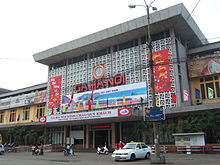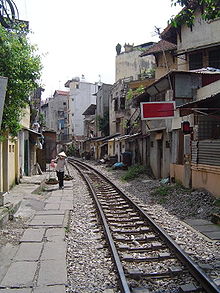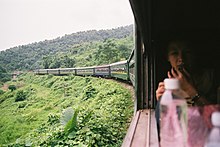Đường sắt Việt Nam
The Vietnamese Railway , Vietnamese Đường sắt Việt Nam (ĐVN), English Vietnamese National Railway (VNR), is the state railway of the Republic of Vietnam .
history
After the fall of Saigon on April 30, 1975, Vietnam was reunified and the Vietnam War ended. The North Vietnamese State Railways took over the facilities and vehicles in South Vietnam . They were badly damaged both in the south and in the north. The repairs began immediately. This was only possible by shutting down other railway lines and expanding material there. For example, the Tháp Chàm – Đà Lạt railway line was stripped of its superstructure and has not been reopened to this day.
On December 31, 1976, the continuous operation of the Hanoi – Ho Chi Minh City railway , as Saigon was now called, began operating as a symbol of the reunification of the country. In the beginning, this happened under very simple operational conditions, which only allowed top speeds of around 30 km / h. At that time only one single class was offered . It was not until the 1990s that the efficiency of the 1930s was reached again.
| year | time | annotation |
|---|---|---|
| 1977 | 66 hours | |
| 1988 | 58 hours | |
| 1999 | 32 hours |
In 2000 new passenger cars could be procured. Nevertheless, it is only a project for the next few years to replace all passenger cars that are approved for a top speed of only 60 km / h
The Vietnamese transport minister carried out a railway reform on April 10, 1990, the name of the state railway was now given in English as "Vietnam Railway Union". The next railway reform followed through a decree of the Prime Minister in 2003: The now still valid name (English Vietnamese National Railway - VNR) was introduced. In 2005 parliament passed the first railway law. In 2010 there was another - legal - restructuring: A decree of the Prime Minister founded the state railway into a GmbH , of which the state is the sole shareholder . In 2015, 24 companies in the railway sector were merged with the ĐVN: two other railway companies , two manufacturers of rolling stock and 20 companies that deal with the maintenance and management of railway infrastructure. As a rule, they are set up as stock corporations , but all of their shares belong to VNZ.
On June 16, 2017, the country's parliament passed a new railway law.
network
The network has a route length of 2437 km, the track length including overtaking and station tracks is 3159 km. That is 7.64 km of railway line per km². Of this, 2,148 km are meter gauge, 150 km are standard gauge and 234 km are designed as three-rail tracks. None of the lines are electrified , they are all single-track . There are 259 operating points , 1,840 bridges , 39 tunnels and 5,726 level crossings .
The ĐVN operates the following routes:
| Route (ĐVN classification) | Route in Wikipedia | length | Gauge | annotation |
|---|---|---|---|---|
| Hanoi – Ho Chi Minh City | Hanoi – Ho Chi Minh City railway line | 1726 km | 1000 mm | |
| Hanoi - Haiphong | Yunnan Railway | 96 km | 1000 mm | |
| Hanoi - Lào Cai | Yunnan Railway | 285 km | 1000 mm | three-rail track in sections with 1435 mm |
| Hanoi - Đồng Đăng | Hanoi – Đồng Đăng railway line | 165 km | 1000 mm, 1435 mm | |
| Hanoi - Quan Trieu | 55 km | 1000 mm, 1435 mm | ||
| Kep - Ha Long - Cai Lan | 108 km | 1435 mm | sections of three-rail track with 1000 mm | |
| Luu Xa - Kep | 57 | 1435 mm | sections of three-rail track with 1000 mm | |
| Bac Hong - Van Dien | 40 km | 1000 mm |
The railway infrastructure is underfunded and the lack of investment funds is the main problem.
Geographical conditions
The route network of the ĐVN is characterized on the one hand by the extreme north-south expansion of the country: The majority of the network is therefore allocated to the Hanoi - Ho Chi Minh City rail line , on which the majority of the investments are used. The infrastructure is further characterized by the mountainous topography in the south and on the border with China in the north, which makes numerous engineering structures necessary.
In the northern part of the country, on the other hand, in the area of the Red River delta, there is very flat terrain with little incline, which is also densely populated. A railway network has developed here, with Hanoi in the center.
Historically traditional structures
The routes created in the French colonial era were built in meter gauge. Since the People's Republic of China supported North Vietnam in the Vietnam War, a railway line from China to Hanoi was built during this time , albeit in the standard gauge of 1435 mm. From this a small network of its own developed in the north-east of the country. At the point where the two gauges meet, three lines have also been partially developed as three - rail tracks.
present
Infrastructure
The performance of the existing infrastructure is limited. Above all, it is annoying that all routes are single-track and the platforms are only 250 m or 350 m long.
There are railway depots in Hanoi, Vinh , Da Nang and Ho Chi Minh City.
There have been attempts to cautiously privatize peripheral areas of business, such as leasing warehouses and workshops and renting office space, business space in train stations and advertising space. For this purpose, twelve regionally responsible departments have been set up to deal with the use and maintenance of the railway's own real estate and station management.
vehicles
The ĐVN operates 293 diesel locomotives from 14 different series . 40 of them are from Vietnamese production. These all have an output of less than 2,000 hp , which is largely sufficient, since other factors in the network limit the use of more powerful machines. However, there are plans to procure 100 locomotives with more than 2,000 hp for heavy freight trains.
Locomotives, passenger and freight wagons can be manufactured in two plants that are formally outsourced as stock corporations but belong to the ĐVN.
business
The ĐVN operates according to an annually revised timetable . The train traffic is controlled by a central train control, which operates with branch offices in Hanoi, Da Nang and Ho Chi Minh City. Tickets can be booked electronically.
Passenger traffic is also offered on six routes , international traffic also via the Đồng Đăng / Pingxiang border crossing to China. The second border crossing to China, Lào Cai / Sanai , is also used for freight traffic . Three train types are offered on the north-south route :
- express
- Limited Express Intercity
- Intercity
The trains are air conditioned and offer four classes of: Hard seat (real "wood class"), soft seat, hard couchette (six-bed compartment) and soft sleeper (Quadruple compartment).
In 2017, 5.6 million tons of goods and 9.5 million passengers were transported.
future
The government has approved a development plan for the railways up to 2020 and a perspective paper covering the period up to 2050. The aim is to expand the infrastructure, in particular to improve its connection to industrial sites and ports, to develop its own railway industry, to procure modern vehicles and to improve the training of railway workers.
As part of German development aid, the ĐVN is to be equipped with modern, electronic train protection based on GSM-R .
A new line between the two largest cities in the country, Hanoi and Ho Chi Minh City, which should allow higher speeds, is sought.
Worth knowing
The ĐVN is a founding member of the OSJD and is a member of the UIC .
It maintains a railway school with locations in Hanoi, Da Nang and Ho Chi Minh City, where 6,000 students are educated.
In 2014 ĐVN received the “Golden Chariot Award” in Berlin .
literature
- NN: Vietnamese Railway: Challenges Opportunities and Developement . In: OSJD Bulletin 2/2018, pp. 1–11.
- Florian Schmidt: Vietnam. Railway between Mekong and Red River = steam and travel / Überseeische Eisenbahnen 6 / 1989. [With numerous other references from the mid-1980s.]
- Vu Anh Minh: A message [...]. In: Vietnamese Railway: Challenges Opportunities and Developement . In: OSJD Bulletin 2/2018, p. 1f.
Web links
- Homepage of the Vietnamese Railway "Vietnam Train" .
- The man in seat 61. A beginner's guide to rail travel in Vietnam .
Remarks
- ↑ The main train station in Ho Chi Minh City is still called "Saigon".
- ↑ The same source also gives the number 2532 km.
- ↑ It is in this context explicitly not by a high-speed line spoken, but the description "medium high speed line" used (Vu Anh Minh: A message , p.1).
Individual evidence
- ^ NN: A Brief History of Dalat Railroad . 2007.
- ↑ Schmidt, p. 7.
- ↑ Schmidt, p. 12.
- ↑ Schmidt, p. 7.
- ^ NN: Vietnamese Railway , p. 4.
- ^ NN: Vietnamese Railway , p. 4.
- ^ NN: Vietnamese Railway , p. 4.
- ^ NN: Vietnamese Railway , p. 11.
- ^ NN: Vietnamese Railway , p. 3.
- ^ NN: Vietnamese Railway , p. 4.
- ^ Vu Anh Minh: A message , p. 1; NN: Vietnamese Railway , p. 5.
- ^ NN: Vietnamese Railway , p. 5.
- ^ NN: Vietnamese Railway , p. 6.
- ^ So: NN: Vietnamese Railway , p. 5; ibid., p. 7 this is given as the number of stations in the network.
- ^ NN: Vietnamese Railway , p. 5.
- ^ NN: Vietnamese Railway , p. 6.
- ^ Vu Anh Minh: A message .
- ^ NN: Vietnamese Railway , p. 11.
- ^ NN: Vietnamese Railway , p. 8.
- ^ NN: Vietnamese Railway , p. 8.
- ^ NN: Vietnamese Railway , pp. 5, 7.
- ^ NN: Vietnamese Railway , p. 8.
- ^ NN: Vietnamese Railway , p. 9.
- ^ NN: Vietnamese Railway , p. 8.
- ^ NN: Vietnamese Railway , p. 8f.
- ^ NN: Vietnamese Railway , p. 7.
- ^ NN: Vietnamese Railway , p. 8.
- ^ Homepage of the Vietnamese Railway; The man in seat 61; NN: Vietnamese Railway , p. 7.
- ^ NN: Vietnamese Railway , p. 5.
- ^ Vu Anh Minh: A message .
- ^ NN: Vietnamese Railway , p. 7.
- ^ Vu Anh Minh: A message .
- ^ NN: Vietnamese Railway , p. 8.
- ^ NN: Vietnamese Railway , p. 10.
- ^ NN: Vietnamese Railway , p. 8.
- ^ NN: Vietnamese Railway , pp. 9, 11.








